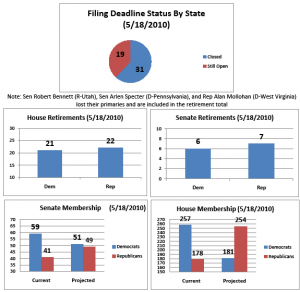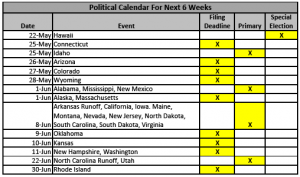
Elections Calendar
Latest News – Filing Deadlines
There will be no filing deadlines until May 25, when filing ends in Connecticut. After that will see a rapid succession of filing deadlines: Arizona (May 26), Colorado (May 27), Wyoming (May 28), and Alaska/Massachusetts (June 1). Once those deadlines have passed, we will know who is running for Congress in 38 states. The last Congressional filing deadline will be Delaware’s, on July 30.
Latest News – Retirements
In the wake of the May 6 David Obey (D-Wisconsin) retirement, there was the abrupt resignation of Mark Souder (R-Indiana) Tuesday because he had an affair with an aide. This brings the total number of Congressional retirements to 56 (43 in the House and 13 in the Senate). We also have recently found out that 2006 freshman Michael Arcuri (D-New York) has decided to run for re-election after all.
A final word on the Pennsylvania special election
Despite the fact that incumbent/establishment candidates had a bad night during Tuesday’s primaries, many pundits have chosen to focus solely on the Democratic victory in the special election in Pennsylvania to fill the seat of the late John Murtha. In doing so, they are neglecting several important facts that paint a more complex picture:
(1) Though this was a district that, as the pundits told us, McCain won, his victory in 2008 was 49-49%. Four years before that, John Kerry won with 51%. And in the 2000 Bush/Gore election, Gore won 55-44%. Going further back in time, an even more conservative incarnation of this district only gave Ronald Reagan a bare 50-50% victory while he was re-elected in a 59-41% landslide in 1984. In other words, what we have is a district with a New Deal Democratic/union heritage that is sympathetic towards pork barrel oriented congressmen;
(2) The special election held was not the only item on the ballot. In fact, turnout was influenced by the high wattage gubernatorial and Senate primaries on the Democratic side, which meant that advertising for Democratic candidates saturated the airwaves and undoubtedly brought more Democrats to the polls;
(3) One analysis which should have been performed but wasn’t was an examination of who went to the polls in the counties making up the Congressional district. District wide, Mark Critz’s victory was 53-45%, while 60% of the primary vote was cast in the Democratic primary. In other words, Democrats had a huge head start here;
(4) Three of the smaller counties did see more Republican than Democratic primary activity, but it only represented 56% of the votes cast, and even then, Tim Burns only carried these counties 53-45%. In other words, he actually LOST some Republican votes to the Democratic candidate;
(5) In the larger counties which represented the lions share of the district wide vote, 64% of the voters in those counties chose a Democratic ballot, and Critz won these counties 54-44%. In other words, you had a 10% crossover of voters who chose a Democratic ballot then voted Republican for Congress. However, the Democrats had more votes to spare than the Republicans did;
(6) It also didn’t hurt that Critz had local roots in the community as a regional director for the late Congressman John Murtha for 12 years, and he cemented those ties by establishing his conservative credentials even while accepting organizational and financial help from the national Democrats;
(7) The circumstances mentioned above were all favorable to the Democrat in this race. This combination of circumstances will not be present in the fall balloting. Plus, the races this fall will involve Democratic incumbents with a record that has to be defended against skeptical voters. Finally, it’s worth noticing that Critz only ran 4% ahead of Barack Obama in Tuesday’s election.
Looking Ahead
This Saturday at 6PM (Hawaii time), we will know the winner of the “winner take all” Hawaii special Congressional election. Turnout as of Tuesday was 43%, and we believe by Saturday it will be in the 50-55% range. Republican Charles Djou has maintained a strong lead in this “winner take all” election; the question is how close to 50% he can get when the balloting is completed.
After the Saturday special election, the only other election in May will be the Idaho primary next Tuesday. After that, three states (Alabama, Mississippi, and New Mexico) hold primary elections on June 1. We are particularly interested in a House race in Northern Alabama, where last year, conservative Democrat Parker Griffith changed from Democrat to Republican. Though the party establishment has done what it can to help Griffith out, local Republicans haven’t been entirely happy with this arrangement, and two Republicans are opposing him in the primary. This scenario (political classes versus the masses) sounds eerily similar to Pennsylvania, except that the party switch was a more natural fit for Griffith than it was for Arlen Specter (who actually switched parties twice in his political career).
After June 1 will be another “Super Tuesday” on June 8, with 10 states’ holding primaries. In addition, the political future of Blanche Lincoln (D-Arkansas) will be decided in a runoff on that same date. This runoff will determine whether she becomes the third incumbent Senator (and the fourth Congressional incumbent) to be defeated.
At that point, 25 states will have held their primaries, and the general election campaigns will really start to take shape then.
John is a political consultant and blogger with JMC Enterprises with expertise in poll sample development and analysis, development of targeted voter files for phone canvassing or mail outs, campaign strategy and demographic consulting, among other things. See his site at WinWithJMC.com for more information.
Advertisement
Advertisement


